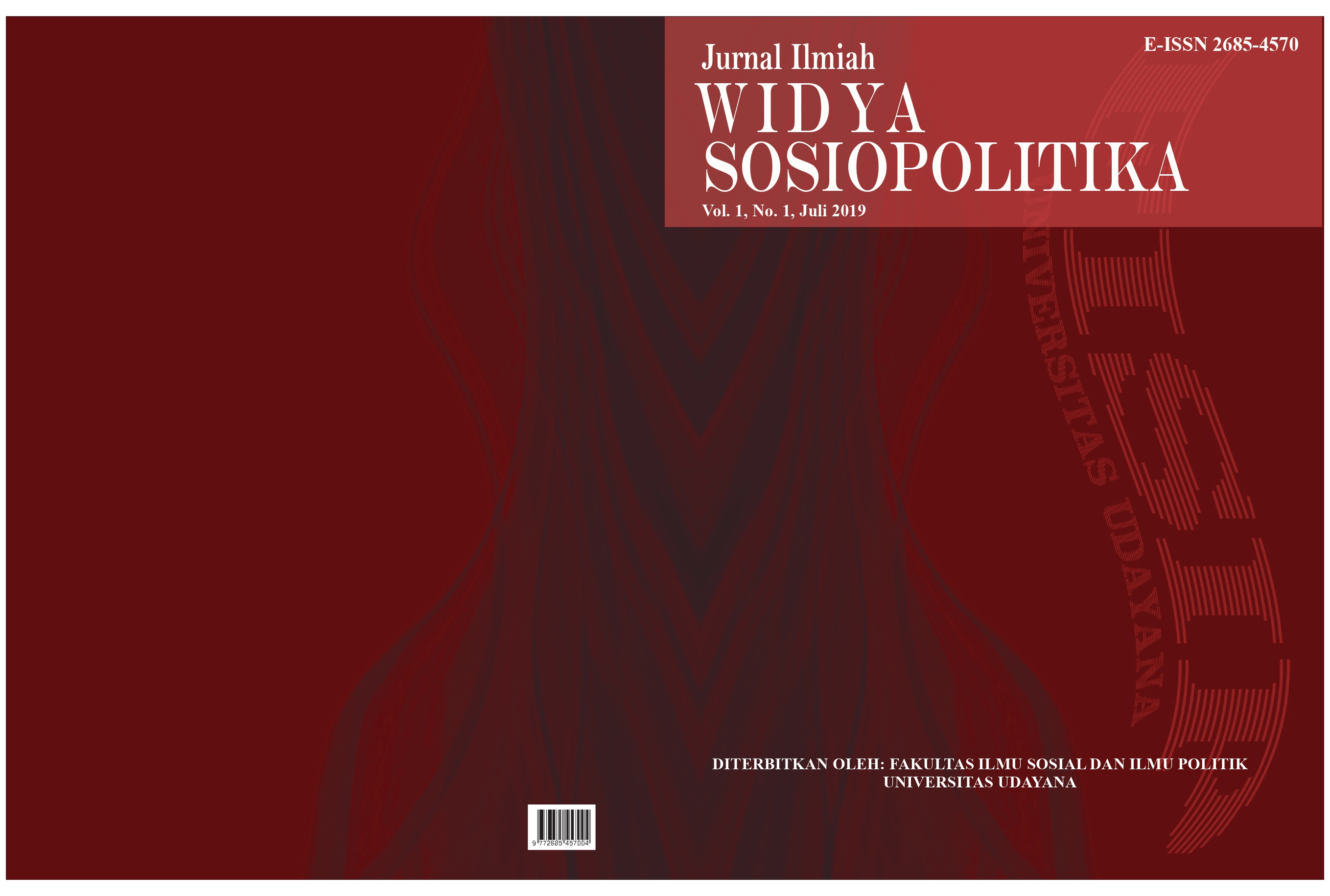KESIAPAN PENERIMAAN TEKNOLOGI BAGI DOSEN DALAM MENGADOPSI IMISSU DI UNIVERSITAS UDAYANA
Abstract
ABSTRAK
IMISSU merupakan sebuah sistem terintegrasi milik Universitas Udayana yang bertujuan untuk mewujudkan self service technology pada organisasi. Dosen sebagai salah satu pengguna IMISSU diharapkan mampu mendokumentasikan kegiatannya dengan memanfaatkan IMISSU. Namun, sebelum seorang individu memutuskan untuk menerima atau menolak sebuah teknologi, kesiapan mereka untuk menerima teknologi menjadi satu hal yang penting. Penelitian ini bertujuan untuk menjelaskan kesiapan dosen di Universitas Udayana untuk mengadopsi IMISSU sebagai sebuah inovasi. IMISSU merupakan sistem terintegrasi milik Universitas Udayana unutk mempermudah civitas akademika dalam melakukan pekerjaan. Sebanyak 157 dosen yang memiliki akun dan menggunakan IMISSU secara reguler menjadi sampel dalam penelitian ini. Kesiapan dosen dalam mengadopsi IMISSU diukur dengan menggunakan Indeks Kesiapan Teknologi yang meliputi empat dimensi, yaitu optimism, keinovatifan, ketidaknyamanan, dan ketidakamanan. Penelitian ini menggunakan metode survey dan data dianalisis secara deskriptif kuantitatif. Hasil penelitian ini menemukan bahwa rata-rata skor untuk keempat dimensi adalah tinggi. Hal ini berarti bahwa dosen di Universitas Udayana memiliki pandangan positif terhadap IMISSU sebagai sebuah inovasi. Namun, perasaan ketidaknyamanan masih ada karena kompleksitas fitur IMISSU.
Kata kunci: dosen, IMISSU, Indeks Kesiapan Teknologi.
ABSTRACT
IMISSU is an integrated system ini Udayana University which help organization to create self service technology. Lecturers as one of the IMISSU’s user were expected to keep their activities in IMISSU. However, it is important to measure the readiness to adopt or reject the technology. The aim of this study is to describe the readiness of lecturers in Udayana University to adopt IMISSU as an innovation. IMISSU is an integrated system in Udayana University to help organization’s member work easier. The subject of this study was 157 lecturers who had account in IMISSU and used IMISSU regularly. The readiness of lecturers to adopt IMISSU was measured by Technology Readiness Index, which is included four dimensions, optimism, innovativeness, discomfort, and insecurity. Survey technique was used and the data were analyzed by descriptive quanitative. This study found that the average scores for all dimensions were high. It means the lecturers were accepted IMISSU as an innovation positively. In other side, they still felt uncomfortable with the features of IMISSU because of its complexity.
Key words: IMISSU, Lecturer, Technology Readiness Index.
Downloads
References
Cooper, Donald R. dan C. William Emory, 1998. Metode Penelitian Bisnis. Edisi Kelima. Jakarta: Erlangga.
Demirci, Ahmet Emre and Nezihe Figen Ersoy. 2008. “Technology Readiness Innovative High-Tech Products: Hw Consumers Perceive and Adopt New Technology”. The Business Review, Cambridge. Vol: 11. December, No. 1. Page 302-309.
Ho, Shu-Hsun and Ying-Yin Ko. 2008. “The Effects of Self-service Technology on Customer Value and Customer Readiness: The Case of Internet Banking”. Internet Research. Vol.8: No. 4. Page 427-446.
Indriantoro, Nur dan Bambang Supomo. 2002. Metodologi Penelitian Bisnis: Untuk Akuntansi dan Manajemen. Edisi Pertama: Yogyakarta: Badan Penerbit Fakultas Ekonomi UGM.
Jogiyanto, Muhammad dan Willy Abdillah. 2009. Konsep dan Aplikasi PLS (Partial Least Square) untuk Penelitian Empiris. Yogyakarta: Badan Penerbit Fakultas Ekonomi UGM.
Kriyantono, Rachmat. 2006. Teknis Praktis Riset Komunikasi. Jakarta: Kencana. Littlejohn, Stephen W dan Karen A. Foss. 2009. Teori Komunikasi. Edisi Sembilan. Jakarta: Salemba Humanika.
Minishi-Majanja, Mabel K. and Joseph Kiplang’at. 2005. “The Diffusion Of Innovations Theory As A Theoritical Framework In Library And Information Science Research”. Journal of Library and Information Science. Vol. 71: No. 3. Page: 211-224.
Neuman, W. Lawrence. 2014. Social Research Methods: Qualitative and Quantitative Approaches. Seventh Edition. Essex: Pearson.
Parasuraman, A. 2000. “Technology Readiness Index (TRI): A Multiple-Item Scale to Embrace New Technologies”. Journal of Service Research. Vol. 2: No. 4. Page: 307-320.
Rogers, Everett M. 2003. Diffusion of Innovations. sFifth Edition. New York: The Free Press.s
, 1986. Communication Technology: The New Media in Society. New York: The Free Press.
Sekaran, Uma and Roger Bougie. 2009. Research Methods for Business: A Skill Building Approach. West Sussex: Wiley.
Sugiyono. 2008. Metode Penelitian Bisnis. Bandung: Alfabeta.
Taylor, Steven A, Kevin Celuch, and Stephen Goodwin. 2002. “Technology Readiness in the e-Insurance Industry: An Exploratory Investigation and Developmentof an Agent Technology e-Consumption Model. Journal of Insurance Issues. Vol. 25: No. 2. Page: 142-165.
Tsikriktsis, Nikos. 2004. “A Technology Readiness-Based Taxonomy on Customers: A Replication and Extension”. Journal of Service Research. Vol. 7: No. 1. Page: 42-52.
Universitas Udayana. 2016. Borang Akreditasi Institusi Universitas Udayana: Standar 4. Jimbaran: Universitas Udayana.
Yieh, Kaili., Jiun-shan Chen, and Maggie Biwei Wei. 2012. “The Effects of Technology Readiness on Customer Perceived Value: An Empirical Analysis”. Journal of Family and Economic Issues. Vol. 33. Page 177-183.
Survei Kepuasan Pengelolaan SDM Unud. 2016.
https://www.unud.ac.id/in/bincang1173-IMISSU-Bersatu-Membangun-UNUD-.html.Diakses pada 2 Februari: 14.00 Wita.




1.png)

3.png)








 Diterbitkan oleh Fakultas Ilmu Sosial dan Ilmu Politik Universitas Udayana
Diterbitkan oleh Fakultas Ilmu Sosial dan Ilmu Politik Universitas Udayana
